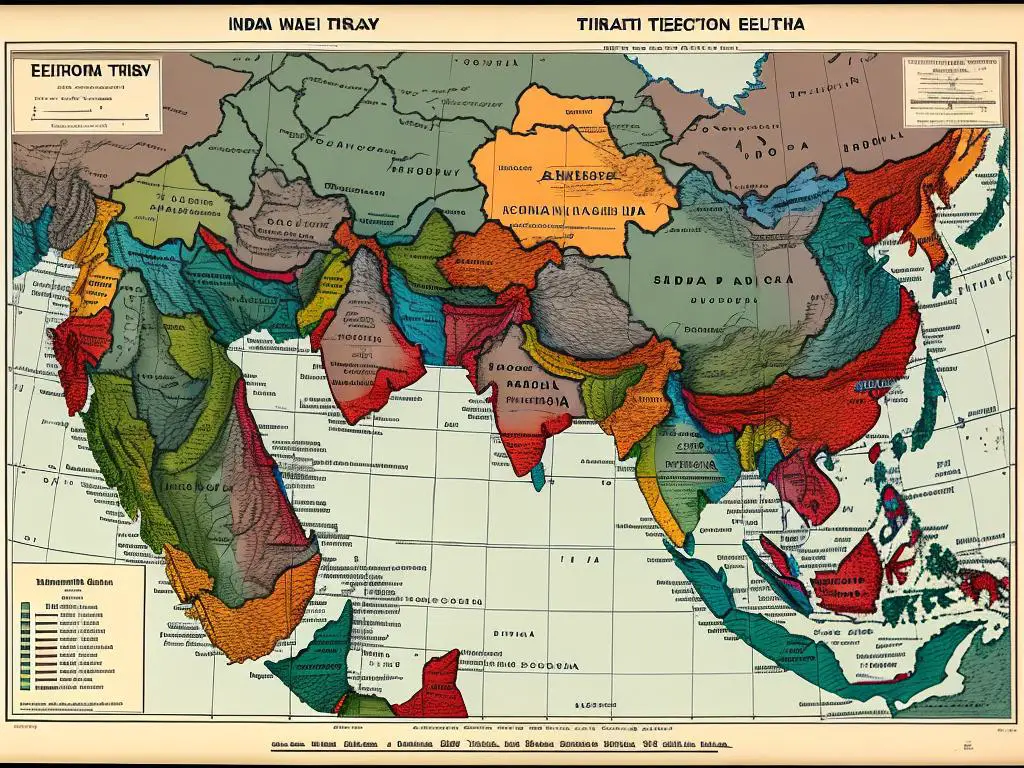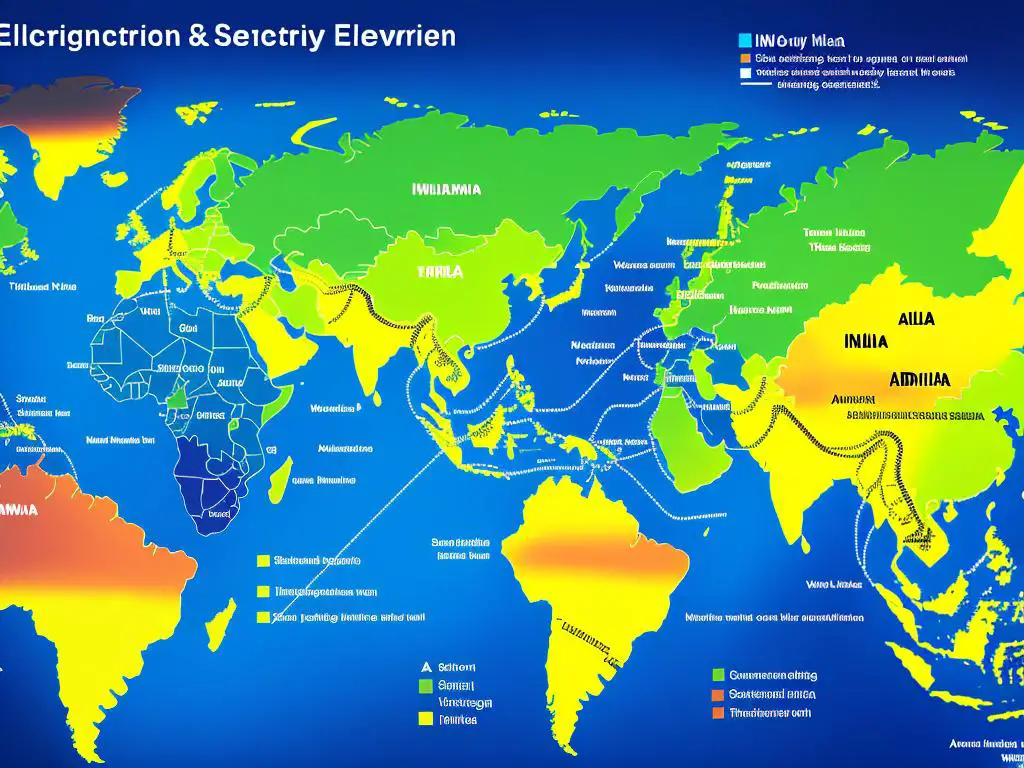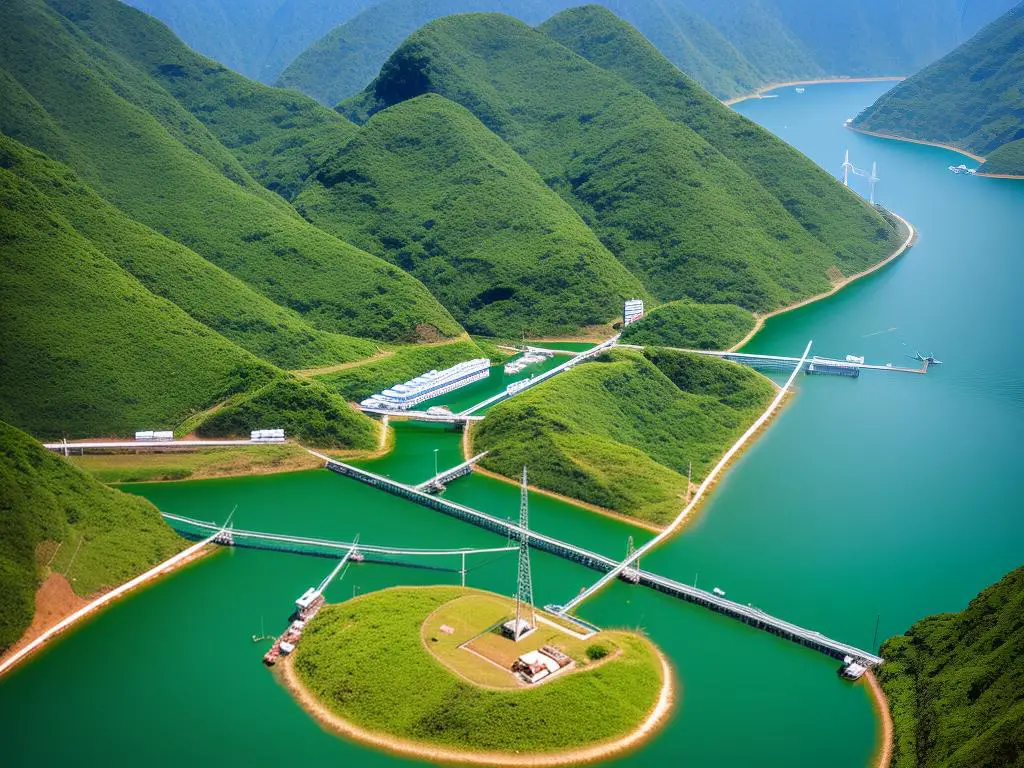India’s Power Play: Trading Electricity with Southeast Asia: India, in the last decade, has emerged as an energy giant, steering the wheel of its powerful energy market towards sustainability and eco-friendly practices. Blessed with an array of renewable energy resources and a thriving traditional energy market, India has an ample surplus to accommodate the rising demand. With increasing capacity, the idea of cross-border electricity trade is not just an opportunistic venture but a feasible and beneficial measure for both India and prospective partner countries. This exploration of India’s plans to extend its electricity trade to Southeast Asia dives into the depths of this concept, its potentials, and reciprocal impacts.
India’s Current Energy Market (India’s Power Play: Trading Electricity with Southeast Asia)
India’s Energy Market Conditions
In recent years, India has emerged as one of the largest consumers and producers of energy in the world, with the third-largest energy consumption globally. This significant energy consumption is primarily driven by the rapid economic and population growth in India, which in turn continues to increase the demand for energy. The country’s energy mix is diverse, with conventional sources like coal, crude oil, and natural gas accounting for the majority of India’s energy supply. On the other hand, renewable energy sources like solar, wind, and hydro-electric generation have been gaining momentum in recent years.
Understanding Substation Automation & IoT Concepts: A Complete guide for beginner
India’s Progression towards Renewable Energy
The Government of India has set ambitious goals to increase the share of renewable energy in the country’s total energy mix as part of its commitment to mitigate climate change. The country has seen a sharp rise in investment in renewables, particularly solar energy, leading to a significant drop in renewable energy prices. This trend is expected to continue as technology advancements, policy support, and economies of scale drive down costs further.
India in the Global Energy Market
India has become increasingly important in shaping the global energy markets due to its rising demand and the scale of its clean energy ambitions. The country is currently a nett energy importer; however, recent trends suggest that India could transition to becoming an energy-exporting country soon. Furthermore, due to its geographical location and the surge in renewable energy generation, India has the potential to become a regional power hub, exporting electricity to neighboring regions.
India’s Energy Surplus and Consumption Trends
While India has traditionally struggled with energy deficits, the situation has significantly improved over the years. Improvements in generation capacity, energy efficiency, and transmission infrastructure, coupled with a slowed growth in demand, have led to an energy surplus scenario. The residential sector is the largest energy-consuming sector, followed by the industrial sector. There has also been a marked shift in energy consumption patterns in recent years, with an increasing number of consumers opting for cleaner energy sources.
India’s Aim to Trade Electricity with Southeast Asia
Recognizing the opportunity to tap into the energy demand in Southeast Asia, India aims to establish cross-border electricity trading. The focus of such cross-border exchanges would be primarily renewable energy, aligning with India’s national green growth priorities and contributing to global efforts to mitigate climate change.
The Southeast Asian region has significant demand for electricity due to its socio-economic development and urbanization. Moreover, these countries are increasingly open to procuring renewable energy due to their sustainability agendas. Thus, the interconnection of electricity networks between India and Southeast Asia could be a win-win situation for both sides, allowing the trade of renewable energy in a region with massive growth potential, and helping India to diversify its energy export markets.
In a Nutshell
With impressive progress in the energy sector, India has transitioned from being a nation once severely energy-deficient to now being rich in energy supplies. There has been a major emphasis on the production of renewable energy, supporting India’s ambitions to act as a regional energy hub. Their plans to initiate cross-border electricity trade with Southeast Asia is not only a strategic thrust to expand their energy export markets but also a significant contribution toward regional cooperation and the broader objectives of sustainable development.

The Idea of Electricity Trade
Decoding Cross-Border Electricity Trade
Simply put, cross-border electricity trade is the process of trading power across the boundaries of nations. This system allows countries with a surplus of power to sell it to those that are experiencing power shortages.
Seamless integration of energy markets to maximize the use of resources is the chief goal of cross-border electricity trade, which in turn fuels a more effective and efficient electricity market. This approach comes with a plethora of advantages including reduction in costs, enhanced grid dependability, and a strengthened energy security for the nations involved.
The Benefits and Challenges of Electricity Trade
The benefits of such transactions are multifold. Countries engaged in electricity trade can optimize their power resources, lower electricity cost, enhance power security and stability, and reduce pollution by maximizing the use of clean energy.
Meanwhile, these benefits come with certain challenges. The most significant of which is the monumental initial investment required for establishing the necessary infrastructure, such as cross-border transmission lines. The economic feasibility of these projects, particularly in developing countries, is often under scrutiny.
There are additional challenges as well, such as harmonizing the regulatory frameworks of participant countries, managing the complex economics of power pricing, and ensuring the agreed-upon power standards are maintained.
Overcurrent Protection in Power Substation
Examples of Global Electricity Trade
Electricity trade is already a common practice in several parts of the world. In Europe, for instance, countries like France and Germany have been trading electricity for years. Meanwhile, in Africa, the Southern African Power Pool (SAPP) allows member states to sell their surplus electricity on a common platform.
India’s Strategy to Trade Electricity with Southeast Asia
Over recent years, India has progressively considered cross-border electricity trade with Southeast Asia. This initiative fits into India’s ‘Look East Policy’, a foreign policy strategy designed to establish comprehensive economic and strategic ties with the countries of Southeast Asia.
As part of this strategy, India is understood to be in the process of negotiating power trade agreements with Thailand and Myanmar, using its excess hydro and thermal electricity as a point of discussion.
Efforts are also being made toward investing in the requisite infrastructure needed for this ambition. This is seen in the development of the India–Myanmar–Thailand Trilateral Highway and the Kaladan Multi-Modal Transit Transport Project, both of which will play vital roles in connecting to Southeast Asia’s power grid.
In addition to infrastructure, India is crafting a strong legal and regulatory framework to overcome potential challenges, thus maintaining the standardization of electricity.
Despite these measures, various challenges persist. India must address issues such as potential adverse effects on local communities and the environment due to large infrastructure projects, the intricacies of international power pricing, and harmonization of regulations with other countries in Southeast Asia.
In summary, while the thought of trading electricity with Southeast Asia seems economically and strategically promising for India, the effective implementation of such an initiative necessitates extensive planning, substantial investments, and meticulous regulatory cooperation among the involved nations.

India’s Efforts & Planning
Expansion of India’s Electricity Trade to Southeast Asia
India is amongst the nations seeking to diversify their energy trade and is particularly interested in broadening their electricity trade to Southeast Asia. Given India’s strategic geographical location and its swiftly evolving power sector, the country stands as a compelling candidate for energy collaboration with neighboring countries.
Cross-border Power Grids
Central to this initiative is India’s proposal for cross-border power grids. Indian authorities have drafted plans to connect the country’s extensive power network with those of its Southeast Asian neighbors. This connectivity would allow for the seamless transfer of electricity across regions, fostering a trading relationship based on energy.
Arrangements with Neighbouring Countries
India has been making concerted efforts to build fruitful energy relationship with its neighboring countries. For example, as part of this initiative, memorandums of understanding have been signed, detailing the intention to collaborate on energy generation and distribution projects. These agreements, often backed by high-level country-to-country dialogue, aim to solidify cooperation in the power sector. They also pave the way for technical discussions on grid integration, power exchanges, and compatibility of systems.
Infrastructure and Regulatory Requirements
For these ambitious plans to materialize, a variety of infrastructural and regulatory changes will need to be addressed. For example, substantial investments in transmission infrastructure will be necessary to physically connect India’s grid with those of its neighbors. This will require not only the construction of grid interconnection, but also strategic planning to ensure the reliability and security of cross-border power exchanges.
On the regulatory front, the synchronization of electricity markets and regulatory structures poses another challenge. India and the Southeast Asian nations will need to harmonize trading rules, tariff structures, and grid codes to create a smooth trading environment. Moreover, arrangements will have to be made for dispute settlement, mutual assistance in emergencies, power purchase agreements, and potential third-party access.
Overview
By looking to forge cross-border power grid agreements with its neighboring countries, India aims to significantly increase its presence in the Southeast Asian power market. Despite the challenges posed by the necessary infrastructure and regulatory alterations, India’s consistent efforts underscore its dedication to broaden its influence within the power sector beyond its own borders.

Impacts on Southeast Asian Countries
India’s Objective: Supplying Electricity to Southeast Asia
Recently, India has demonstrated a growing interest in supplying electricity to Southeast Asia. Owing to India’s considerable surplus of power, the country could potentially gain a crucial advantage over Southeast Asian nations, where the demand for energy remains consistently high.
Economic Impact
First, the economic impacts stand as a significant benefit for Southeast Asia. These countries are among the fastest growing economies globally, with increasing industrialization and urbanization. The cost of electricity production in these countries is high due to lack of advanced technology and expertise in power generation.
India, on the other hand, has a widespread network of power generation and infrastructure spread across several states and union territories, offering more competitive prices. Importing electricity from India can help Southeast Asian countries reduce their costs, leading to increased economic efficiency, greater industrial output, and better macroeconomic performance.
Social Impact
From a social perspective, access to affordable electricity could lead to better living conditions and improved societal wellbeing. Electric power, being a critical service, would provide for better healthcare and education, promote industry, entrepreneurship, and digitization, especially in rural areas.
Although this is a positive aspect, some may argue that the local energy industry’s job losses in Southeast Asia might be a considerable social detriment. However, the trade could also create new jobs in areas like power management and energy market regulation.
Environmental Impact
When it comes to environmental impact, trading electricity with India may lead to mixed consequences. India’s energy matrix, while diversified, still relies heavily on coal. If the traded power comes from coal-fired power plants, it could increase Southeast Asian countries’ carbon footprint indirectly.
However, India is also a global leader in renewable energy production, particularly solar power. If this green energy is part of the power trade, it could help Southeast Asian nations meet their respective renewable energy targets and reduce global greenhouse emissions.
Shifting Power Dynamics: India’s Potential Energy Trade with Southeast Asia
India’s potential contribution to the energy market in Southeast Asian countries could mark a significant turning point. This power trade could spur progress in power infrastructure development and competitively diversify pricing in the existing energy sector. It’s also possible that countries might lean more heavily on imported energy, thus underscoring the necessity for robust energy policies and collaborative approaches in the region. This move may encourage other countries with surplus energy to consider power trades, facilitating the creation of a globally interconnected power grid.

Challenges & Prospects
Pursuing Regional Power Synergy: India’s Proposed Electricity Trade with Southeast Asia
India, a burgeoning global player, is keen on extending its sphere of influence in the Southeast Asian region through electricity trade. This bold move dovetails with India’s broader vision of fostering heightened regional power interplay – a vision that the Indian government has been nurturing for some time.
Though pursuing this vision is fraught with hefty challenges – political complexities, geographical constraints, technical issues to name a few – the potential benefits that India and the Southeast Asian region could reap, if these challenges are surmounted, are substantial.
Political Challenges
Trading electricity across borders necessarily entails political negotiations and agreements. India will have to negotiate several bilateral and multilateral agreements with several Southeast Asian countries, each with its own set of regulatory and legal frameworks for energy trade.
Moreover, power integration on this scale may raise concerns about energy dependence and security amongst these nations. In addition, varying political stabilities among some countries in the region could pose a risk to the sustained functioning of such complex inter-regional networks.
Geographical Challenges
Geographical factors also present a considerable challenge. The physical transmission of electricity across multiple borders will necessitate elaborate transmission infrastructure. The construction of high-voltage direct current (HVDC) transmission lines over long distances, particularly through challenging terrains and across water bodies, can prove to be both technically demanding and financially straining.
Technical Challenges
Technical hurdles are bound to surface with such efforts. India operates its grid at 50 Hz, which may not be compatible with the grids of some Southeast Asia where a grid frequency of 60 Hz is common. This discrepancy in grid frequencies could need sophisticated conversion technologies at border points, adding to the complexity and cost of operations.
Furthermore, reliable grid operation demands precise balancing of supply and demand at all times. Interconnection of grids across diverse countries will require robust load management and effective coordination among the involved nations.
Prospects: More than Just Power
Despite these challenges, India’s aspirations to trade electricity with Southeast Asia bring along substantial prospects. If successfully achieved, regional power integration could boost the deployment of renewable energy and its grid integration across the participating nations. India, with its ambitious renewable energy goals could both enhance and leverage this aspect.
India’s efforts could also spur socio-economic development in the region. Construction of the necessary infrastructure could generate jobs, while the improved electricity supply could stimulate growth in other sectors, particularly in rural and less-developed regions.
Furthermore, power interconnection between India and Southeast Asia could foster deeper regional integration and cooperation, contributing to enhanced peace and stability in this strategically significant region.
In conclusion
India’s plans to trade electricity with Southeast Asia, if successfully executed, could serve as a model of regional power interchange. Despite the numerous challenges, this venture could have profound implications for India and its Southeast Asian neighbors, making it a significant endeavor to watch.

The venture of cross-border electricity trade between India and Southeast Asia, despite the challenges it might encounter, harbors considerable promise for both parties involved. The potential benefits ranging from economic gains to environmental sustainability cannot be overlooked, but achieving these goals will require comprehensive planning, robust infrastructure, successful negotiations, and strong regulatory frameworks. This proposed electricity trade presents an exciting frontier for India’s energy market, with the potential to reshape the energy landscape across Southeast Asia and foster stronger regional relationships through mutual interconnectivity and benefit.
